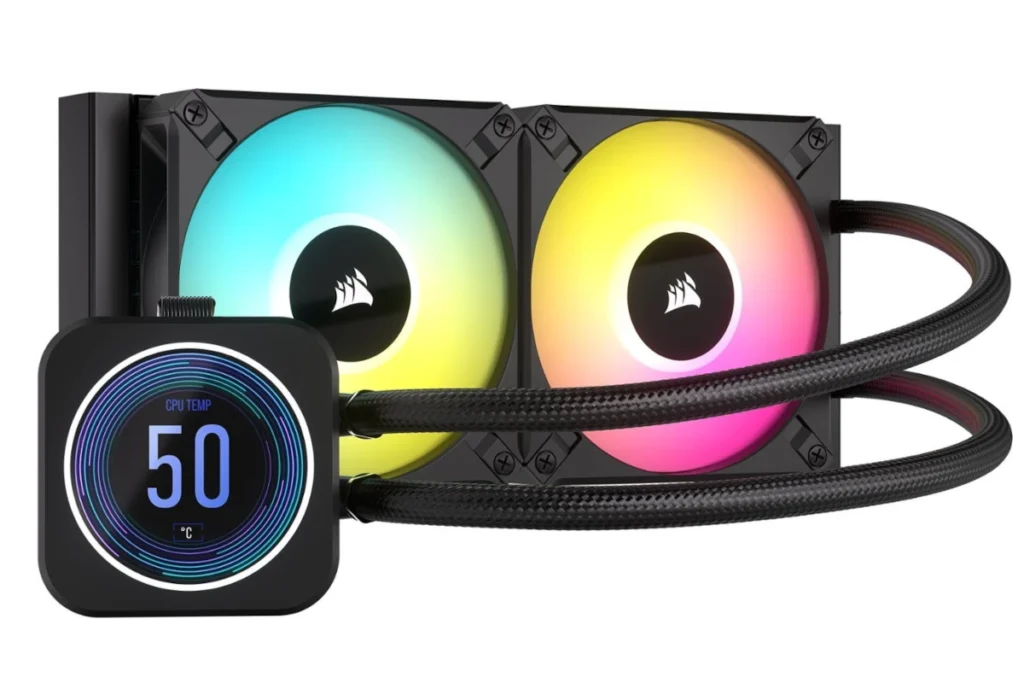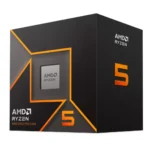Effective CPU cooling when building a computer is an important factor to consider whenever building or upgrading. If CPUs generate heat that isn’t properly dissipated, it can lead to reduced performance or hardware damage. Air coolers have been commonly used, but now there are more advanced options like All-in-One (AIO) coolers. These AIO coolers combine a pump, radiator, and attached fans to circulate coolant around the CPU, expelling heat more efficiently than air coolers. They are easy to install and provide superior cooling, making them a favorite among overclockers and gaming enthusiasts. As technology progresses and CPUs become more powerful, understanding AIO cooling systems becomes important for optimizing thermal performance and ensuring the longevity of computer components.

Liquid Cooling Solutions for Your PC: AIO Coolers
Understanding AIO Coolers
All-in-one (AIO) liquid coolers offer a simple way to improve your computer’s cooling performance. They come pre-filled and pre-assembled, making them easier to install than custom liquid cooling loops. AIO coolers typically consist of a pump, a radiator, and fans. The pump circulates coolant through the system, absorbing heat from the CPU or GPU and transferring it to the radiator. The radiator then dissipates the heat into the surrounding air, aided by the fans.
Advantages of AIO Coolers
AIO coolers offer several advantages over traditional air coolers:
- Improved Cooling Performance: Liquid is more efficient at transferring heat than air, allowing AIO coolers to keep your CPU or GPU cooler under load. This can lead to improved performance and stability, especially when overclocking.
- Quieter Operation: AIO coolers are often quieter than air coolers, especially at high loads. This is because the fans on the radiator don’t need to spin as fast to achieve the same cooling performance.
- Easier Installation: AIO coolers are easier to install than custom liquid cooling loops. They come pre-filled and pre-assembled, and most models require only a few simple steps to install.
Factors Affecting Thermal Efficiency
The thermal efficiency of an AIO cooler depends on several factors:
- Radiator Size: Larger radiators have more surface area to dissipate heat, resulting in better cooling performance.
- Fan Speed and Airflow: The fans on the radiator play a crucial role in dissipating heat. Higher fan speeds and better airflow can improve cooling performance but may also increase noise levels.
- Pump Speed: The pump speed determines how quickly the coolant circulates through the system. Higher pump speeds can improve cooling performance but may also increase noise levels.
- Coolant Quality: The type and quality of coolant used in the AIO cooler can affect its thermal efficiency. High-quality coolant can improve heat transfer and extend the lifespan of the cooler.
- Thermal Paste: The thermal paste between the CPU or GPU and the cooler’s cold plate helps to transfer heat efficiently. Using high-quality thermal paste can improve cooling performance.
Popular AIO Cooler Options
| Cooler | Radiator Size | Fans | Features |
|---|---|---|---|
| Corsair H100i Elite LCD | 240mm | 2x 120mm | LCD display, RGB lighting, customizable fan curves |
| NZXT Kraken Z63 | 280mm | 2x 140mm | LCD display with customizable GIFs, RGB lighting |
| Arctic Liquid Freezer II 240 | 240mm | 2x 120mm | Excellent price-to-performance ratio, low noise levels |
| ASUS ROG Ryujin II 360 | 360mm | 3x 120mm | Integrated OLED display, customizable lighting, high performance |
| Cooler Master MasterLiquid ML360L V2 ARGB | 360mm | 3x 120mm | Addressable RGB lighting, dual-chamber pump for quiet operation |
Choosing the Right AIO Cooler
When selecting an AIO cooler, consider your needs and budget. Larger radiators generally offer better cooling performance, but they may not fit in all cases. If noise levels are a concern, look for coolers with low-noise fans or adjustable fan curves. Additionally, consider the aesthetics of the cooler, as many models come with RGB lighting or customizable displays.
Key Takeaways
- Effective heat dissipation is essential for CPU performance and longevity.
- AIO coolers offer a compact, efficient cooling solution for high-performance CPUs.
- Understanding AIO technology is crucial for optimizing a system’s thermal management.
AIO Coolers: Unraveling the Technology
AIO coolers have evolved as a popular solution for managing CPU heat efficiently. They blend the simplicity of air coolers with the efficiency of liquid cooling systems.
Understanding AIO Components
An All-In-One (AIO) cooler consists of several main parts: a pump, a water block that attaches directly to the CPU, radiators of varying sizes to dissipate heat, fans to move air over the radiator, and tubing that connects these components in a closed loop. The size of the radiator, often referred to by its dimensions such as 240mm or 360mm, can impact the cooler’s ability to control temperatures. For example, the Lian Li Galahad II Trinity is noted for its significant 360mm radiator. These coolers also contain a blend of water and coolant for transferring heat away from the CPU.
Comparing AIO and Air Coolers
AIO coolers distinguish themselves from traditional air coolers by relocating the heat exchanger away from the CPU, offering better airflow inside the chassis. They usually permit lower noise levels as well, as AIO fan speeds can be regulated more efficiently compared to air coolers, especially under high TDP conditions. Air coolers rely on large heat sinks and fans that sit directly atop the CPU and are typically more affordable and easier to install, but may fall short in thermal performance when compared to AIOs, particularly in overclocking scenarios.
Installation and Compatibility
Installation of an AIO cooler requires fitting the radiator into the case, securing the water block onto the CPU with thermal paste, and connecting the fans. Compatibility is crucial, as the AIO must match the CPU socket, whether it’s an AM4, Intel LGA1700, or any other. Products like the Corsair iCUE H170i Elite Capellix XT often boast wide compatibility with various CPU sockets. Additionally, the physical size of the AIO should be considered – a larger radiator will need ample case space.
Performance Metrics and Overclocking
Performance of AIO coolers is measured by their ability to maintain low CPU temperatures, even during intense workloads. Key metrics include heat dissipation capability and thermal performance, which can be enhanced by optimizing fan speed. AIOs generally deliver the cooling needed for stable overclocking, provided the cooler’s TDP rating exceeds the CPU’s heat output. RGB lighting is a feature in some models, like the Deepcool Gammaxx L240 V2, serving no cooling function but favored for aesthetic value.
FAQs
What does AIO cooling mean?
AIO stands for “All-in-One” and refers to a type of liquid cooling system for CPUs. AIO coolers are self-contained units that include a pump, radiator, and fans, pre-filled with coolant and ready to install. They offer a more efficient cooling solution compared to traditional air coolers, especially for high-performance CPUs or overclocking scenarios.
Is AIO better than CPU cooler?
Whether an AIO cooler is better than a traditional CPU air cooler depends on your specific needs and priorities. AIOs generally offer superior cooling performance, quieter operation, and a cleaner aesthetic in your PC case. However, they can be more expensive and carry a slight risk of leaks, although this is rare with modern AIOs. Air coolers, on the other hand, are typically more affordable, easier to install, and require no maintenance.
What are the cons of AIO cooler?
Some potential downsides of AIO coolers include:
- Higher cost: AIOs are generally more expensive than comparable air coolers.
- Potential for leaks: Although rare, leaks can occur, potentially damaging your PC components.
- Limited lifespan: The pump and fans in an AIO cooler have a finite lifespan, typically around 3-5 years.
- Bulkier installation: AIOs require space for the radiator and fans, which might not be suitable for small form factor PC cases.
Do AIO coolers need to be refilled?
Most AIO coolers are sealed units and do not require refilling under normal circumstances. The coolant is pre-filled and designed to last the lifespan of the cooler. However, some high-end or custom AIOs might offer refilling options for enthusiasts who want to customize their cooling loop.
What is the lifespan of an AIO cooler?
The lifespan of an AIO cooler typically ranges from 3 to 5 years, depending on the quality of the components and usage conditions. The pump and fans are the most likely components to fail over time. If you notice a significant decrease in cooling performance or unusual noises from the pump or fans, it might be a sign that your AIO cooler is nearing the end of its lifespan.
What liquid should I put in my AIO?
You should not attempt to put any liquid in your AIO cooler unless it’s specifically designed to be refilled. Most AIOs are sealed units and using the wrong type of coolant can damage the cooler or your PC components. If you’re unsure, consult the manufacturer’s instructions or seek professional assistance.







